|
 Printer-Friendly Version Printer-Friendly Version
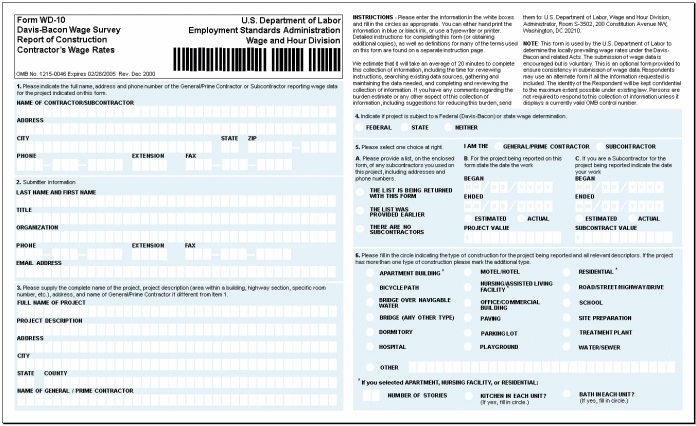
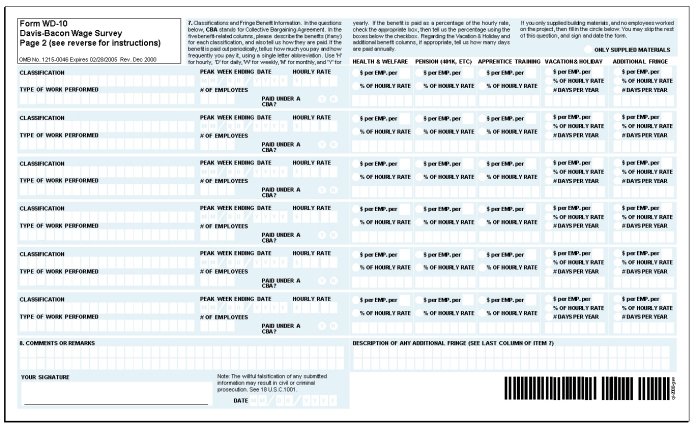
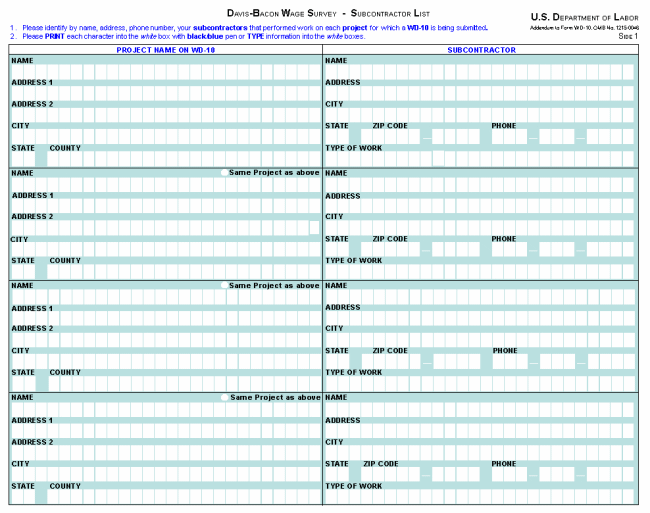
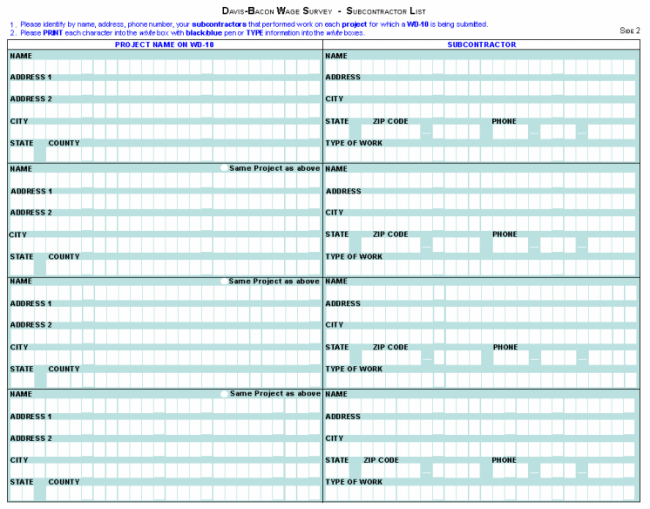
Instructions for the WD-10
Davis--Bacon Wage Survey
Report of Construction Contractor-s Wage Rates
Information about Davis-Bacon Wage Surveys, including dates of current
and future surveys, may be obtained at the Davis-Bacon and related
Acts (DBRA) web site at www.dol.gov/esa/whd/programs/dbra/index.htm.
INSTRUCTIONS
- Use blue or black ink.
- Hand-print letters/numbers.
- Use one block for each letter, number, period, or space. If you use a typewriter or printer to complete this form,
ignore the block spacing.
- Fill in circles completely.
- Use one WD-10 form for each construction project.
This form is machine readable, and should not be copied. For additional
forms, please contact (1-866-487-9243), OR fill out and submit your
forms electronically using the following site on the World Wide
Web: http://www.dol.gov/esa/whd/programs/dbra/wd-10.htm.
FORM SIDE 1
Sections 1 and 2 -- Contractor and Submitter Information
1.
Fill in with information about your company.
2. Fill in with information about the submitter of the form.
Sections 3, 4, 5, and 6 -- Project Information
3. Fill in information about the construction project
your company worked on and the project's location and description.
4. Fill in one circle to identify if the project
was subject to a federal or state wage determination.
5. Fill in one circle to identify yourself as either
the general/prime contractor or a subcontractor.
5A. Indicate if you had no subcontractors, OR if you did, then
indicate whether you are enclosing a list of subcontractors along
with the WD-10 form, or if you submitted a list earlier.
5B. If you were the prime/general contractor, provide the date
any work began on this project, the date the project ended (indicate
if actual or estimated date), and the total project value.
5C. If you were a subcontractor, provide the date your work started
and ended (indicate if actual or estimated date) and the subcontract
value.
6. Mark the type of construction project your company
worked on. If none of the construction types matches your project,
fill in the circle next to OTHER, and indicate the type of construction
in the blocks. If you selected APARTMENT BUILDING, NURSING/ASSISTED
LIVING FACILITIES, or RESIDENTIAL, indicate the number of stories,
and fill in the circle if there was a kitchen and/or a bath in
each unit.
FORM SIDE 2
Section 7 -- Classification and Fringe Benefits
- If you only supplied materials, and no employees worked on the
project, then fill in the circle marked "Only Supplied Materials,"
skip the rest of section 7, and sign and date the form.
- The remainder of section 7 requests multiple types of information
per classification. Fill in each item as defined and described
as follows:
- Classification(s) are the position titles of jobs within
your company (e.g., Carpenter, Electrician, Laborer, Crane Operator,
etc.). Fill in one classification per line. If the workers in
a classification are paid more than one hourly rate or different
fringe benefits, please list them on separate lines. If more
than 6 classifications and wage rates need to be listed for
a project, report the additional classifications and wage rates
on a new WD-10. On the new WD-10 fill out only Sections 1, 3,
and 7.
- Type of Work Performed - Explain the type of work that each
classification performs (e.g., Laborer: landscape, unskilled,
pipelayer; Carpenter: carpentry, drywall; Operator: backhoe,
etc.).
Examples:

Section 7 -- Classification and Fringe Benefits (continued)
- Peak Week Ending Date is the week you had the largest number of employees
in a classification.
- Number of Employees is the largest number of employees working
in this classification on this project.
- Hourly Rate is the dollar amount you paid employees per hour
working in this classification.
- CBA -- If the employee is paid under a Collective Bargaining
Agreement, fill in the circle that represents Yes, otherwise fill
in the circle that represents No.
- Fringe Benefits are paid in addition to the hourly rate. Report
only the costs or contributions incurred by your company, NOT
the employees. Do not include costs paid by the employer that
are required by either Federal, State, or local law such as worker's
compensation or unemployment insurance. Fill out the information
under each fringe benefit that applies.
- Health & Welfare -- Medical or hospital
care, or insurance to provide such care, life insurance, long--
or short--term disability, sickness, or accident insurance.
- Pension (401K, etc.) -- Retirement/401K, defined contribution
plans (including savings and thrift, deferred profit sharing
and money purchase pension), annuity cost, or cost of insurance
to provide such a benefit.
- Apprentice Training -- Defrayment of the cost of apprenticeship
or similar training programs.
- Vacation & Holiday -- The payment of compensation for
holidays and vacation.
- Additional Fringe -- If you are not sure of the category of
the fringe benefit(s), enter the rate information in the column,
and specify the fringe type in the "Description of Any
Additional Fringe" field at the bottom of the form.
Fringe benefits can be paid by a straight
dollar amount, or by a percentage of the basic hourly rate. Indicate the
cost or contribution your company paid to this classification during the
peak week of this project.
If the fringe benefits were paid by a straight dollar amount:
Dollars ($) per Employee (EMP.) per
- Mark the circle before $ per EMP. per
- Fill in the dollar value in the blocks provided.
Include the decimal position when you fill in the dollar amount. Do not include the $ sign. (Example: 1.50 for one dollar and
fifty cents.)
- Indicate how often this dollar value was paid in the
block following $ per EMP. per with the values as follows:
H for Hourly, D for daily, W or weekly, M for monthly,
and A for annually/yearly.
Example - If an employee was provided a straight dollar amount of $1.50 on a weekly basis for health and welfare:
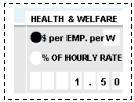
Item 8 -- Comments or Remarks and Signature
- Comments or remarks -- Provide comments or additional information.
- Signature -- Submitter must sign and date the form.
KEY TERMS
- Apprentice -- A person employed and registered in a
bonafide apprenticeship program. (If these Apprentices/Trainees
are in a formal program approved by the U.S. Dept. of Labor, Bureau
of Apprenticeship and Training (BAT), or a state apprenticeship
agency recognized by BAT, then information regarding wages and
fringe benefits need not be provided.)
- Helper -- A person that helps or assists and whose duties
are distinct from the journey level class and laborer.
- General/Prime Contractor -- The principal contractor
on the project.
- Subcontractor -- A contractor working on the project
responsible for specific work but not the overall project. You
are not a subcontractor for purposes of this survey if you supplied
only materials.
- Subcontractor List -- A machine--readable form for reporting
the names and addresses of any subcontractors used by the contractor/subcontractor
on the project being reported.
- Trainee -- A person registered in a construction occupation
program.
|







